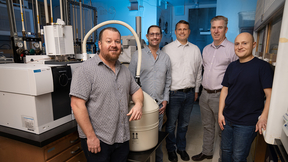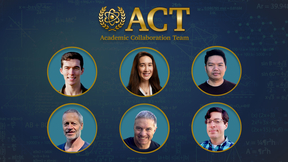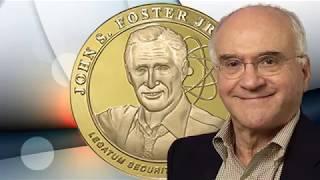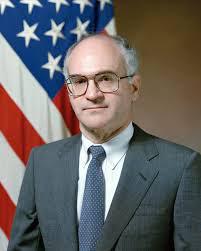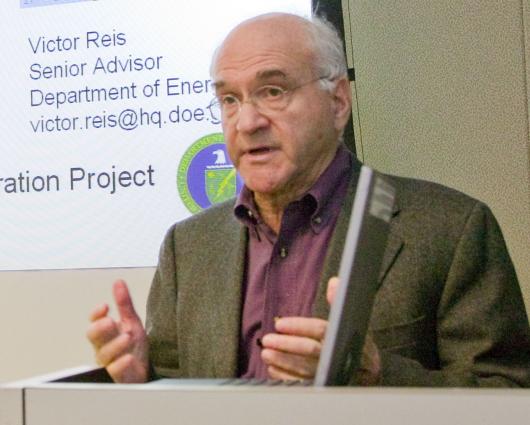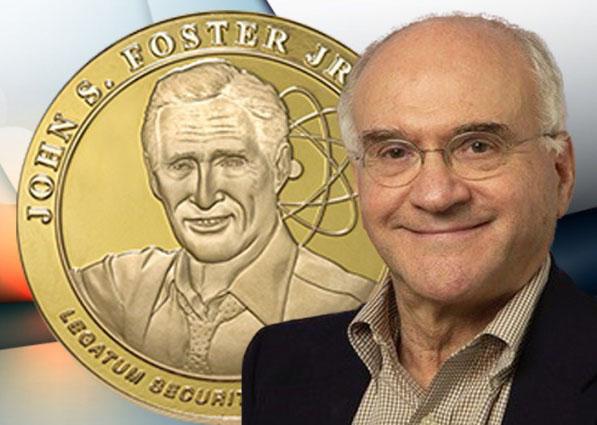Lawrence Livermore to honor the architect of science-based stockpile stewardship
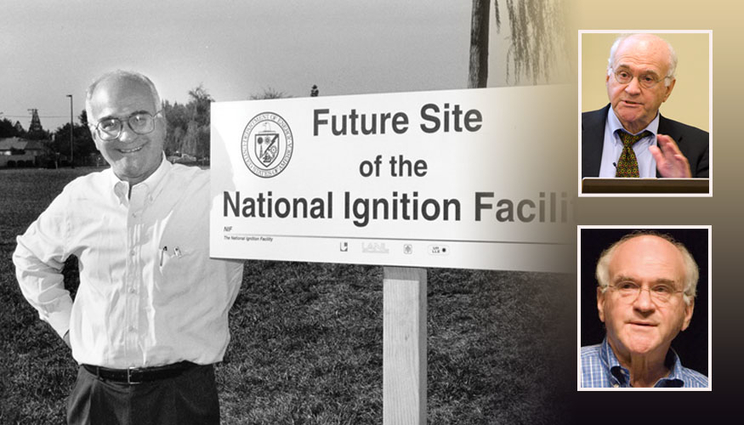 (Download Image)
Victor Reis, known as the architect of science-based stockpile stewardship, has won the prestigious John S. Foster Jr. Medal for his exceptional leadership in support of U.S. nuclear security.
(Download Image)
Victor Reis, known as the architect of science-based stockpile stewardship, has won the prestigious John S. Foster Jr. Medal for his exceptional leadership in support of U.S. nuclear security.
Victor Reis faced an audacious challenge when he accepted the appointment as assistant secretary of Defense Programs in the Department of Energy in 1993. One year prior, President George H.W. Bush agreed to end nuclear testing. Gone were the days of Lawrence Livermore and Los Alamos national laboratories competing to stockpile the next new warhead design, and gone was the visceral certainty and confidence that earth-shaking tests in the desert provided.
Reis had to figure out how to lead the nation’s laboratories into a new era and maintain confidence in the nuclear stockpile without testing. A piece of his budget was already set aside for the task when he took the reins, and Congress had already given it a name: stockpile stewardship. The only problem was that Reis wasn’t sure it would work.
"It was clear to me that creating stockpile stewardship would be the main priority," Reis said. "But it was quite a gamble at the time. It was quite controversial. A lot of people didn’t think you could maintain the stockpile without testing. On the other end, people were questioning why we would need a major program at all given that the Cold War was over."
This grand challenge would define his career and forever change the nuclear weapons complex. Now known as the architect of science-based stockpile stewardship, Reis will visit Lawrence Livermore National Laboratory next week to accept the prestigious John S. Foster Jr. Medal for his exceptional leadership in support of U.S. nuclear security.
Assemble the ‘navigators’
His first move was to get the leaders of the nuclear weapons programs into a room, "lock the doors" and sketch out what science-based stockpile stewardship would look like. Lawrence Livermore, Los Alamos and Sandia national laboratories each had two leaders present during the two-day sprint. Reis called this group "the navigators." George Miller, then leader of Livermore’s weapons program and later LLNL Laboratory director, was one of those navigators.
"I have no qualms saying that there wouldn’t be stockpile stewardship without him," said Miller of Reis. "The military were skeptical of science-based stewardship, and many at the time viewed the idea as violating the fundamental scientific paradigm of coupling experiments with theory. I recall Vic asking us if we were willing to bet our country on this idea.
"Part of Vic’s genius was being able to create excitement and consensus around this audacious proposition. He had the ability to pull disparate people together and lead them in strategy creation and then let them go off and execute. He had a tremendous understanding of the difference between leadership and management."
To kick off the two-day strategy session, Reis posed the question: Let’s think about what sort of end state we want to get to, and how do we get there? A significant part of the discussion centered around how the labs would maintain confidence without the ability to do full scale testing. But there also was recognition that the weapons complex would have to change. It would have to be recapitalized, and the navigators outlined the types of technologies that would be important.
"These were the people who were going to be responsible," Reis said. "They didn’t say they couldn’t do it, or that they would need 10 times the money. Leaving that meeting, the plan just sort of smelled right. Looking back, things have pretty much played out according to what the group put together."
Putting the plan into action
In the brave new world of science-based stockpile stewardship, researchers would need to rely on supercomputers as their virtual test ground. To achieve this goal, the navigators surmised that they would need about 1 million times the supercomputing power within 10 years.
In addition to increased computing power, the complex would need to beef up its experimental capabilities. After all, a simulation is worthless if you can’t conduct focused experiments to prove the physics and material science is correct. To maintain confidence without testing, researchers would need a better understanding than was required when they could simply test their devices. Big questions were still unanswered and there wasn’t yet an experimental facility that could match the high energies and densities that occur in a thermonuclear detonation.
"There were a number of items that were still unknowns in terms of testing," Reis said. "Empirical results that people didn’t understand. We felt it was really important to better understand the materials and what happens at these really high pressures and densities. It was very, very hard, but also the sort of challenge that the labs are designed to go after."
From the outset, understanding the complexities of plutonium proved crucial. A vigorous program of subcritical and shock-physics experiments was conducted at the Nevada Test Site to better understand plutonium behavior. In addition, non-nuclear hydrodynamic testing capabilities were dramatically improved with construction of the Contained Firing Facility at Livermore’s Site 300 and the Dual Axis Hydrodynamic Radiographic Test facility at Los Alamos.
In the quest to better understand the physics of thermonuclear burn, Livermore pressed forward with building a flagship experimental facility, the National Ignition Facility. The plan was to use the largest, highest-energy laser system ever built to produce the high temperatures and pressures seen in nuclear weapons. The only problem was that construction of the massive facility was controversial. To get to the bottom of the issue, Reis turned to someone he had served with on various defense boards since the 1970s: John S. Foster Jr.
"I called him up and I said, ‘Could you go to Livermore and tell me what you think?’" Reis said, well aware of Foster’s reputation as someone who did not blindly support Livermore’s laser program. "When he called back, he told me that it was going to be a very important experimental facility. When he put his stamp on it, someone with his technical ability and vision, I really trusted it."
Successes pile up
The first major success of the Stockpile Stewardship Program came in 1999 when Livermore researchers completed the first ever refurbishment and certification of a nuclear warhead in the post-testing era. This work ensured that the W87 warhead could remain part of the enduring stockpile beyond 2025, and the certification without testing was a groundbreaking milestone for the new Stockpile Stewardship Program.
On the experimental front, researchers achieved a major breakthrough in plutonium aging in 2006. Executing a broad-based program of experiments, simulations and analysis, they developed a much deeper understanding of the detailed properties of plutonium and how it ages in nuclear weapons. This study showed that the performance of plutonium pits in U.S. nuclear weapons will not sharply decline due to aging effects. These definitive results met a major stockpile stewardship milestone and have had important implications for planning the future of the nuclear weapons complex.
By 2008, researchers achieved another major experimental breakthrough, solving a 60-year-old mystery in weapons design that is euphemistically called "energy balance." By pairing detailed computer models with a series of experiments at the National Ignition Facility, researchers were able to explain a phenomenon that perplexed scientists for decades. This breakthrough eliminated a significant source of design uncertainty, further distancing researchers from the need to return to underground nuclear tests. Researchers had managed to answer questions that went unresolved throughout the era of testing. A science-based approach to stockpile stewardship was hitting its stride.
"From a technical and scientific point of view, stewardship was extremely exciting and invigorating," Miller said. "The challenges were immense and the creation and use of the tools was, for many, a once-in-a-lifetime experience. The results exceeded many expectations. In a very real sense, stockpile stewardship reinvigorated the laboratories and created many of the revolutions in the modern approach to technology as a broader legacy."
Today -- a quarter century since the last full-scale nuclear test -- Livermore researchers continue to follow the science-based approach to stockpile stewardship that Reis architected. Pairing modern supercomputers that are hundreds-of-millions of times as powerful as was available in the testing era, and an improved understanding of material properties and thermonuclear physics, they are able to maintain confidence in the safety, security and effectiveness of a stockpile that is older than any that was tested during the underground testing era.
When Reis visits the Laboratory next week, he will be honored as the driving force behind these successes. He will become the third recipient of the John S. Foster Jr. Medal, a distinction only shared by the award’s namesake, and retired Air Force Gen. Larry Welch, who served the 12th Air Force chief of staff and commander in chief of U.S. Strategic Air Command.
"Johnny Foster and Larry Welch are national security giants," Reis said. "They have served our country with great distinction for many years and continue to do so. It has been my good fortune to have worked with them both, and it is an exceptional honor to be associated with them through Lawrence Livermore's John S. Foster Jr. Medal. It doesn't get any better than that."
Contact
Nolan O'Brien[email protected]
925-422-3399
Related Links
About the Foster MedalVictor H. Reis to be awarded John S. Foster Jr. Medal for contributions to nuclear security
Gen. Larry Welch honored for outstanding contributions to national security
Former LLNL Director John Foster Jr. honored for contributions to national security
25 years after the last U.S. nuclear test
Tags
Strategic DeterrenceFeatured Articles

